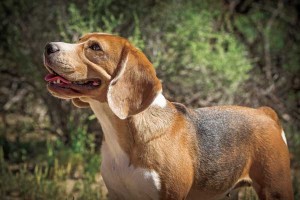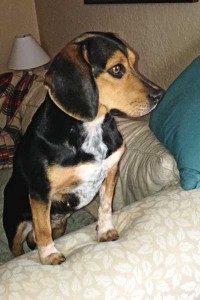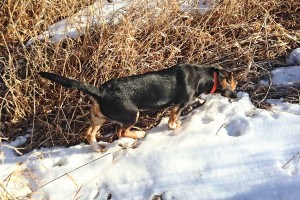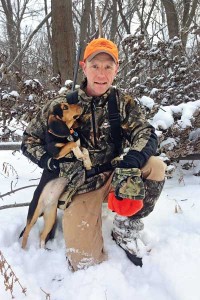 Over the course of my bird hunting life, I've passed up many shot opportunities at fleeing bunnies in the uplands. Rabbits are fun quarry and fine eating, but I didn't want to "ruin" my dogs by encouraging them to chase cottontails.
Over the course of my bird hunting life, I've passed up many shot opportunities at fleeing bunnies in the uplands. Rabbits are fun quarry and fine eating, but I didn't want to "ruin" my dogs by encouraging them to chase cottontails.
Sometime last year, childhood memories of rabbit hunting with my late grandfather—an avid Kentucky "beagler"—planted the urge to get a hound of my own and go kill some easy meat. Let's just say things didn't turn out the way I planned, but I'm hooked on beagling nonetheless.
Here in Iowa, many of the places where I once found large numbers of pheasants and an occasional covey of quail are nearly devoid of both today. There comes a point when you realize you're not really hunting anymore, merely taking a walk with your dog. A Lab never complains, but it's depressing to give them so few opportunities to embody their vocation. Even in ideal habitat, it is now common to walk for miles here without seeing a ringneck.
Meanwhile, rabbits are still plentiful, and the season is five months long. Many sportsmen have abandoned upland birds in favor of deer or wild turkeys for the same reasons, but I'm a dog man at heart. Without the companionship and cooperation of a good pup, hunting feels half-baked to me. So, I needed a rabbit dog.
Beagle Pedigree
The good news is well-bred hunting beagles are much less expensive than bird dogs. Having shared my life mainly with English cockers and British Labs for the past 15 years, I had almost become desensitized to high prices for pups. Much to my surprise, good hunting beagle pups cost in the $200 to $350 range, and well-started beagle gun dogs can often be had for $800 or less.
 The bad news is beagling is a regional phenomenon, and you may live in a place with no hunting beagles. That is especially likely west of the Mississippi River. Despite hours of online searching and two phone calls to regional AKC beagle clubs, I could not locate a breeder within 250 miles of my home. (For a site where you can search for breeders by state, here is good place to start.)
The bad news is beagling is a regional phenomenon, and you may live in a place with no hunting beagles. That is especially likely west of the Mississippi River. Despite hours of online searching and two phone calls to regional AKC beagle clubs, I could not locate a breeder within 250 miles of my home. (For a site where you can search for breeders by state, here is good place to start.)
My search was further complicated by an insistence on acquiring a dog somewhere between started and finished. The process of training a rabbit hound requires large fenced enclosures stocked with semi-wild rabbits. That's well beyond the capability of a city-dweller like me. I eventually found a 13-month-old female named Tillie in Wisconsin for $800.
She's a lovely black-and-tan with blue-tick accents on her chest, and she had two Derby trial placements (second and fourth) before I acquired her. She's a daughter of FC Wright's Little Deacon, apparently a famous dog among beaglers.
Her five-generation pedigree includes no less than 24 different Field Champions (21 male, three female). Now ask yourself what a comparable bird dog or retriever would cost, especially at the semi-finished level.
Before purchasing Tillie, I spoke to several breeders in the Midwest, all avid rabbit hunters. If Tillie had not been available, I would have chosen a pup from one of these breeders and then paid him to keep the dog for the first few months and get it started on rabbits.
All of the breeders recommended I start my beagling journey with a female. (I had Tillie spayed after bringing her home, to dispense with the hassle of heat cycles.) Although they enjoyed hunting with males, they all said beginners will generally find female beagles more biddable, which is an important consideration when switching from bird dogs to your first hound.
Training a Beagle
Tillie is a very good representative of her breed, and she has taught me that even the best beagle is not a Labrador retriever. Many people say hounds are "stubborn," but that puts an unfairly pejorative slant on a character trait that is absolutely essential for a hound.
 More charitable words for this trait include focused, unwavering and perhaps relentless. When their noses are enthralled with something, beagles go deaf. And that's as it should be.
More charitable words for this trait include focused, unwavering and perhaps relentless. When their noses are enthralled with something, beagles go deaf. And that's as it should be.
As a by product of this character trait, you will have your hands full teaching a beagle the sweet little obedience tricks that a retriever learns in just a lesson or two. I'm talking about sit, stay, come, heel, fetch and so forth. With a beagle, it's better to simply get accustomed to carrying a leash and a bag of treats.
With Tillie, this does not appear to be a matter of low intelligence or outright defiance, because she's adorably affectionate and smart as a whip. She house-trained well despite living her first year in an outside kennel. She craves human contact, and suffers separation anxiety when left alone.
This is manageable with behavioral accommodations and an Adaptil pheromone plug-in, and worth noting because I've learned it's relatively common in beagles. They love people almost too much. But that doesn't mean they will follow your orders in lockstep fashion.
However, that's not to say a beagle is an incorrigible scofflaw. I am very much able to control the direction of my hunts, and Tillie stays in contact better than most of the pointing dogs I've known. She will fetch a tennis ball repeatedly, and I am hopeful she may eventually retrieve rabbits; Granddad had some beagles that retrieved.
Will she come to me when I call her? Rarely. But it is easy enough to walk over to her, kneel down, snap the leash on, and walk to the car. I'm not too proud to do that, and maintaining some of her willfulness is actually essential to the hounding enterprise.
Hunting Rabbits with a Beagle
I've heard people scoff at the notion of using dogs for rabbits, saying it's easier to just go out and "kick'em up." They don't realize they are seeing only a fraction of the rabbits. A minority will indeed sit tightly like scattered quail, waiting to be flushed. The majority will sneak out ahead of you. To kill these rabbits you need hounds.
When a beagle strikes hot rabbit scent, the dog locks onto the track and begins baying loudly while tracking. By listening to the baying, you can gauge the progress of the pursuit.
Because cottontails are extremely hesitant to leave their small home range, the rabbit will eventually circle back to where the chase began.
 When your beagle starts baying on a track, go somewhere near that spot and find a place where you can see fairly well. Then wait for the rabbit's return.
When your beagle starts baying on a track, go somewhere near that spot and find a place where you can see fairly well. Then wait for the rabbit's return.
When pushed by beagles, rabbits will usually be a fair distance ahead of the dogs, and often will be moving slowly, furtively, pausing frequently to keep tabs on the dogs. You'll be carrying a .410, 28- or 20-gauge loaded with No. 6 or 7½ shot, since a 12-bore really is overkill.
In other words, a beagle's job is to "circle" a rabbit back to the gun. Sounds easy, right? Actually it's much harder than a bird dog's work, when you think about it. In the bird hunting world, most scent work is airborne and produces results fairly quickly. But a beagle must stay with the scent trail of invisible quarry for anywhere from several minutes to nearly half an hour.
The chase may take the dog 200 yards or more away from the gun, through dense cover. In order to execute this task, the dog must not suddenly become concerned about where he or his master is. For that reason, most bird dogs and retrievers do not have what it takes to be rabbit dogs. They just aren't "stubborn" enough.
Moreover, the dog must push the pursuit quickly enough to keep the rabbit moving and prevent it from holing up. This is a lot to ask from a dog, and I've discovered hound men were right when they warned me this would be a tall order for one beagle all by herself. There is a synergy to a beagle pack that produces results more quickly and reliably.
In six outings thus far, I have not yet killed a rabbit. I've had a few very difficult shots that made ruffed grouse hunting seem like target practice. This is partly because I'm inexperienced and not yet adept at choosing a stand location or anticipating how far ahead of the dog the rabbit will be.
I've blown some pursuits because I'm accustomed to hunting with retrievers in constant contact. Consequently, I got worried about a dog I couldn't see and went looking for her—and got busted by the rabbit on its way back. It's also due to my choice of hunting spots, which are almost impossibly thick. Sometimes winning is all about choosing the battlefield.
Tillie has done her job admirably. In her best outing, she circled five rabbits in two hours. In every other outing, when scenting conditions were more difficult (dry, cold) she has struggled to circle the rabbits at all. In her defense, I'm asking her to do something that is almost unheard of in the world of beagling. Nearly all beaglers have multiple dogs.
Before next season, I'll find some other beaglers and swap them some Iowa wine for Missouri hunting, because at this point I'm hooked. And until I bag a bunny, there's unfinished business.






